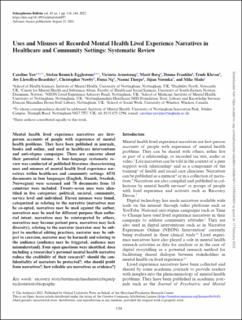Uses and Misuses of Recorded Mental Health Lived Experience Narratives in Healthcare and Community Settings: Systematic Review
Yeo, Caroline; Rennick-Egglestone, Stefan; Armstrong, Victoria; Borg, Marit; Franklin, Donna; Klevan, Trude Gøril; Llewellyn-Beardsley, Joy; Newby, Christopher J.; Ng, Fiona; Thorpe, Naomi; Voronka, Jijian; Slade, Mike
Peer reviewed, Journal article
Published version
Permanent lenke
https://hdl.handle.net/11250/2979551Utgivelsesdato
2021Metadata
Vis full innførselSamlinger
Originalversjon
Yeo, C., Rennick-Egglestone, S., Armstrong, V., Borg, M., Franklin, D., Klevan, T., Llewellyn-Beardsley, J., Newby, C., Ng, F., Thorpe, N., Voronka, J. & Slade, M. (2021). Uses and Misuses of Recorded Mental Health Lived Experience Narratives in Healthcare and Community Settings: Systematic Review. Schizophrenia Bulletin, 48(1), 134-144. https://doi.org/10.1093/schbul/sbab097Sammendrag
Mental health lived experience narratives are first- person accounts of people with experience of mental health problems. They have been published in journals, books and online, and used in healthcare interventions and anti-stigma campaigns. There are concerns about their potential misuse. A four-language systematic re- view was conducted of published literature characterizing uses and misuses of mental health lived experience nar- ratives within healthcare and community settings. 6531 documents in four languages (English, Danish, Swedish, Norwegian) were screened and 78 documents from 11 countries were included. Twenty-seven uses were iden- tified in five categories: political, societal, community, service level and individual. Eleven misuses were found, categorized as relating to the narrative (narratives may be co-opted, narratives may be used against the author, narratives may be used for different purpose than autho- rial intent, narratives may be reinterpreted by others, narratives may become patient porn, narratives may lack diversity), relating to the narrator (narrator may be sub- ject to unethical editing practises, narrator may be sub- ject to coercion, narrator may be harmed) and relating to the audience (audience may be triggered, audience may misunderstand). Four open questions were identified: does including a researcher’s personal mental health narrative reduce the credibility of their research?: should the con- fidentiality of narrators be protected?; who should profit from narratives?; how reliable are narratives as evidence?)

